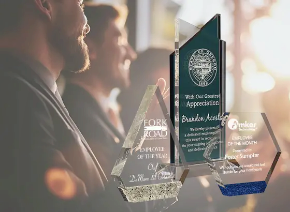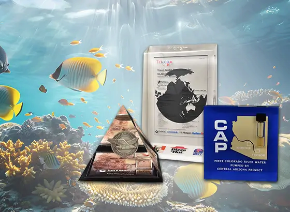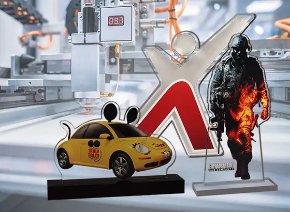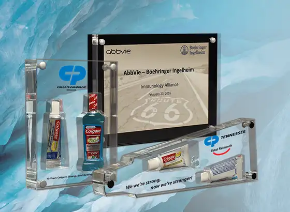
Decoration methods in the recognition industry have changed rapidly over the past 50 plus years.
Not long ago trophy companies were limited to just a handful of decoration methods such as pantograph engraving, automark trophy typewriters, and a small number of chemical etching processes that few shops invested in.
Today, as technology has improved, the resources available to decorate and engrave awards has changed from a labor-intensive process to a fine-tuned process mastered by talented graphic artists capable of producing unique Computer Aided Designs (CAD).
History of CAD engraving
Let’s take a brief look into the history and transition from labor-intensive engraving methods to the now popular computer driven engraving and printing options.
 Pantograph Engravers
Pantograph Engravers
Truthfully there are not many old school engravers left in the awards trade, but any who are still plugging away would say they learned on a pantograph. Developed in the late 1800’s and refined by manufacturer New Hermes, the pantograph used a simple parallelogram linkage that would first trace brass indented tiles and then transfer the tracing via an industrial diamond or rotary attachment to the item to be engraved.
This was a cumbersome process of hand setting type in a tray and making adjustments to scale the engraving so it looked proportionate on trophy and plaque plates. Mistakes were very costly and at that time there was no way to send proofs to a customer prior to engraving.
 Automark Trophy Typewriter
Automark Trophy Typewriter
Some would say the introduction of the trophy typewriter was the beginning of the computer age to trophy shops around the world. Used in the military for several years to mark dog tags, the trophy typewriter became a staple in many production shops as a way to duplicate information quickly by simply typing as the machine stamped the letters on metal plates.
Newer models of the Automark had memory built in so long runs of the same content could be repeated over and over.
 Transition to modern engraving methods
Transition to modern engraving methods
Microchips played an important role in the transition to modern decoration methods and the name that stands out today is the System One computerized engraving machine developed by Dahlgren Engraving Systems in the early 80’s.
Touted as a versatile, fast and easy to use engraving machine – the System One took the trophy and awards industry by surprise. Preprogrammed and connected to a Radio Shack TRS80 console – production centric trophy shops jumped on board and the computer aided engraving industry was born.

Present Day Award Decorating
Now that you have a basic knowledge of what the awards industry looked like prior to the introduction of computers, let’s take a look at how the industry has evolved. But first let’s break decoration methods into four common categories.
- CNC Engraving
- Laser Engraving
- Color Printing
- Sand Etching
Each of these has its own set of benefits and unique applications for manufactured trophies and awards. Rarely will you find a trophy shop without one of these processes available and many are capable of two or more.
 CNC Engraving
CNC Engraving
Very similar in design to the early Dahlgren machines – CNC machines are faster, simpler to operate, and much more versatile than their predecessors. With manufacturing capabilities including depth control and repeatability, the CNC engravers of today have found their way into production facilities around the world.
You will find them engraving multiple different substrates, including Metal, Wood, Plastic, Glass, Custom Signage, ADA Braille, Electrical Tags, Name Plates, Legend Plates, Asset Management, Parts Serialization, Parts Marking, Awards, Trophy Cups, Trophy Plates, Plaques, Watches, Pendants, Rings, Jewelry, ID Plates, Furniture, Dog Tags, and Pens to name just a few.
 Laser Engraving
Laser Engraving
Introduced to the awards industry in the late 80’s, laser engraving technology transformed the industry. Starting from the days of water cooled lasers that had very large physical footprints, many of today’s low watt lasers are small enough to fit on an office desk.
Lasers are known for engraving aluminum, chromium, precious metals, copper, brass, stainless steel, painted metals, titanium, plastics, acrylics, polyester, wood, glass, stones, paper, leather, fabric, ceramic, cardboard, and we’ve even seen a few cigars personalized with a laser machine.
Laser technology has grown beyond its original limitations of surface engraving and now is used in large production facilities to manufacture custom shaped trophies out of acrylic.
 Color Printing
Color Printing
As corporate branding has become more and more important in the recognition industry, so has the introduction of color printing methods like UV (ultra violet) and dye sublimation.
Direct printing on acrylic, glass, and metal offers a level of uniqueness and customization to the award production process that can not be achieved with traditional CNC or laser engraving methods. UV printers are actually very similar to the technology you have in your inkjet printer – with the exception of industrial print heads, they print on flat surfaces and the ink is formulated to cure via ultraviolet light introduced after the ink is sprayed on the substrate. Often used in conjunction with laser cutting the UV printer is best known for creating full color acrylic medals and trophies.
Dye sublimation is another method of full color printing that many trophy shops have added to their repertoire. Offering a full color printing option, dye sublimation uses heat to transfer toner to the surface of special polyester-coated metals. Limited to gold, silver, bronze, and white substrates – sublimation is fast and looks great. Because dye sublimation is heat and light sensitive, it is limited to being effective on awards that will be displayed indoors.
 Sand Etching
Sand Etching
Over the years sand etching or blasting has become more popular with trophy shops. Used to mark glass and crystal – sand etching is primarily done with the use of photosensitive masks that are exposed with light then adhered to the substrate and blasted at low pressure with a very fine grit aluminum oxide grit.
These are popular products purchased primarily by corporations looking for a high-end trophy option. The drawback to crystal and glass awards is often that they can chip or break and are quite heavy to ship which has created a higher demand for custom acrylic awards.
That’s a lot of information to take in and we’re happy you're still with us. Hopefully you learned something about modern engraving and decorating methods.
US Acrylic Awards is an American Manufacturer of fine acrylic awards and embedments to corporations around the world. Committed to manufacturing excellence – our processes include many of the techniques described above and we look forward to working with our clients to develop recognition programs that are out of this world. Let’s get creative!
Written by noptim… unleash the power







